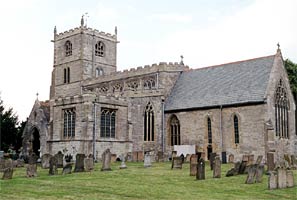 NorwellSt LaurenceNewark Archdeaconry Newark and Southwell Deanery Introduction
Norwell church is surprisingly large, seating about 400 people; this reflects
its historic relationship with Southwell Minster. There have been three prebendaries
or canons of Norwell since the thirteenth century; some of them were rich and
important and contributed to enlarging the church.
Domesday Book mentions a priest in Nortwelle in 1086 but the earliest substantial
part of the existing church building is the late twelfth-century south doorway.
There is evidence that the nave and chancel were built in the late twelfth
century and additions, including two transepts and the clerestory, made between
the thirteenth and fifteenth centuries. The main stone of the church is skerry
(dolomitic sandstone), possibly quarried in nearby Maplebeck.
The dilapidated chancel was restored in 1857 and the rest of the church in
1874 by Ewan Christian, but many earlier features remain.
Points of historic interest include a thirteenth-century aumbry, two fourteenth-century
effigies, a rood stairway, an impressive fifteenth-century clerestory and two
windows with twentieth-century glass by Kempe. In the churchyard are three
seventeenth-century headstones and an interesting sundial.
Just to the south of the church is a moat which marks the site of Overhall
Manor. This belonged to the Prebendary of Overhall and was besieged in the
Civil War.
Particular thanks to Michael and Elizabeth Jones and to the
late Wallace Smith for the research
and to Geoff Buxton, Adrian Davies and Andy Nicholson for the photography
|